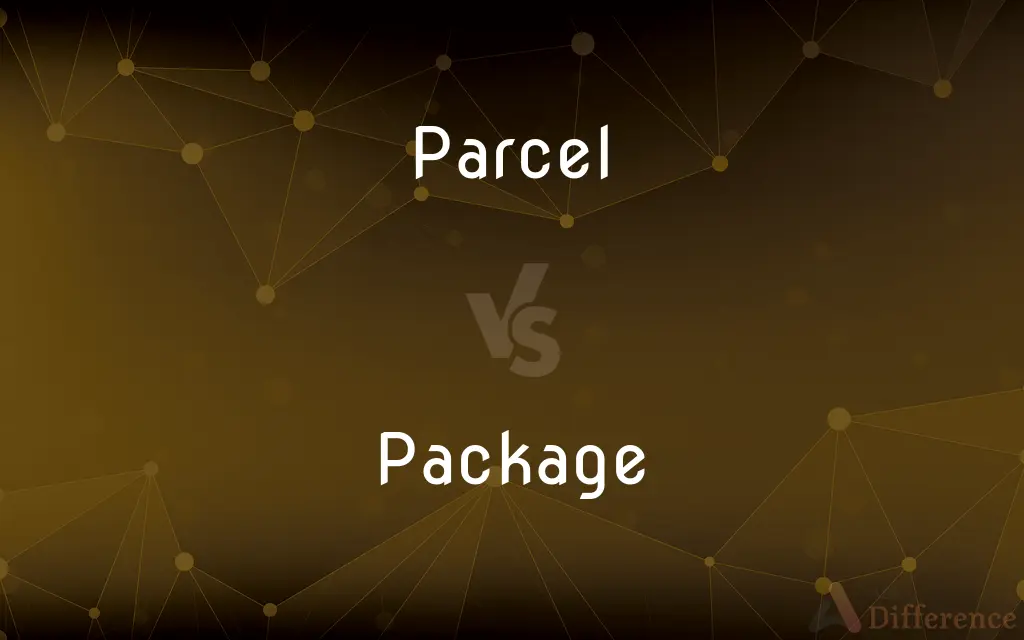Parcel vs. Package — What's the Difference?
Edited by Tayyaba Rehman — By Urooj Arif — Updated on March 5, 2024
A parcel is an item or collection of items wrapped in paper, intended for shipping or delivery. A package, while often used interchangeably with parcel, refer more broadly to any container or wrapping that holds items together for transport, or storage.

Difference Between Parcel and Package
Table of Contents
ADVERTISEMENT
Key Differences
Parcels are specifically associated with the shipping and delivery industry, typically wrapped in paper or other packaging materials, ready for mail or courier services. They imply a certain size and weight suitable for postal services. Packages, on the other hand, encompass a wider range of containers, including boxes, bags, and crates, used for transporting, storing, or selling items. Packages might be found within various contexts, not limited to shipping, such as retail or storage.
While parcels are often sent through mail or delivery services and are associated with personal or business shipping, packages can be used to describe the packaging of consumer goods, software, or other products available for sale. This means that all parcels can be considered packages, but not all packages are parcels. The distinction is subtle and largely depends on the context of discussion.
The terms parcel and package are frequently used interchangeably, especially in reference to items sent or received through the mail. However, when considering logistics or retail contexts, the choice between parcel and package can signal the intended use or the nature of the contents. For example, logistics companies might use parcel to refer to individual shipments, while retailers discuss packaging options for their products.
The term parcel often carries a more traditional or formal connotation, particularly in legal or real estate contexts, where it can refer to a specific piece of land. In contrast, package can also refer to a set of proposals or measures designed to be considered together, highlighting its broader applicability beyond physical items.
The difference between a parcel and a package lies in their typical usage and context. Parcels emphasize the action of sending or receiving items through delivery services, while packages have a broader application, including the containment, presentation, and protection of products across various industries.
ADVERTISEMENT
Comparison Chart
Definition
An item or collection of items wrapped for shipping or delivery.
Any container or wrapping that holds items together for various purposes.
Context
Primarily used in shipping and mail services.
Used across various contexts, including retail, shipping, and storage.
Examples
A wrapped book sent by mail.
A box of cereal, a software bundle, or a parcel ready for shipment.
Connotations
Often implies shipping through postal or courier services.
Broader applicability, including product packaging and bundling of services or proposals.
Usage
More specific to the action of sending or receiving items.
Wider usage in describing how items are contained, presented, or protected.
Compare with Definitions
Parcel
Used in shipping contexts. emphasizing delivery or mail.
Tracking numbers help customers locate their parcels during transit.
Package
Encompasses boxes. bags. and other containers.
She picked up a package from the storage room.
Parcel
Can refer to a piece of land in legal terms.
The company purchased a parcel of land for development.
Package
Refers to retail or consumer goods packaging.
The new package design is more environmentally friendly.
Parcel
Items bundled together and wrapped for delivery.
The courier picked up several parcels for distribution.
Package
A container or wrapping holding items.
The package of cookies was sealed to keep them fresh.
Parcel
Often associated with personal or business mail.
They received a large parcel at the office today.
Package
Used broadly for products. goods. or services.
The software package includes various tools for designers.
Parcel
A wrapped item for shipping.
He sent a parcel containing gifts to his family.
Package
Can imply a set of measures or proposals.
The government introduced a package of reforms.
Parcel
An object or collection of objects wrapped in paper in order to be carried or sent by post
A brown paper parcel
A parcel bomb
The lorry was carrying a large number of Royal Mail parcels
Package
A wrapped or boxed object; a parcel
A package arrived in the mail.
Parcel
A quantity or amount of something, especially as dealt with in one commercial transaction
A parcel of shares
Package
A container or wrapping in which something is stored, transported, or sold
Had trouble opening the package.
Parcel
Make (something) into a parcel by wrapping it
He parcelled up the goods and sent them back
Package
A commodity, such as food, contained in a package and sold as a unit
A package of peanuts.
Parcel
Something wrapped up or packaged; a package.
Package
A combination of items considered, offered, or sold as a unit
A vacation travel package.
Parcel
To wrap something up into the form of a package.
Package
Act or process of packing.
Parcel
Make into a wrapped container
Package
A charge made for packing goods.
Package
A collection of things wrapped or boxed together
Package
A wrapped container
Common Curiosities
How do digital products fit into these definitions?
Digital products, like software, are often referred to as "packages" (e.g., software packages) because they bundle multiple features or services, even though they do not have physical packaging.
Is packaging important for both parcels and packages?
Yes, packaging plays a crucial role in protecting the contents, whether it's a parcel sent through the mail or a package of goods for sale.
Can a package contain multiple parcels?
Yes, in a shipping context, a package can contain multiple smaller parcels, especially in logistics and fulfillment centers.
Are parcels only sent through postal services?
Primarily, yes, parcels are associated with postal and courier services, though the term can be used more broadly in everyday language.
What determines whether something is called a parcel or a package?
The primary determinant is context: a parcel specifically relates to items wrapped for shipping, often through mail or delivery services, while a package has a broader application, including the containment of goods for sale, storage, or transport.
Can the term "package" also refer to non-physical items?
Yes, "package" can refer to non-physical bundles, such as a package of measures, reforms, or services, indicating a broader application beyond just physical containment.
How does the packaging affect the classification as a parcel or a package?
Packaging can influence the term used based on its purpose and design. Items wrapped for individual shipment are often called parcels, while items packaged for retail or grouped together for transport might be referred to as packages. The packaging's function, whether for protection during shipping or retail display, plays a role in this classification.
Can the terms parcel and package be used interchangeably in logistics?
In logistics, the terms can sometimes be used interchangeably, especially when referring to the process of preparing goods for shipment. However, logistics professionals might prefer "parcel" to describe individual mailed items and "package" for the broader concept of goods preparation and containerization.
Is there a size difference between a parcel and a package?
Not necessarily. The terms do not inherently imply a size difference but are more about context. Parcels are typically sized for mail or courier services, while packages can vary widely.
Do the terms vary by region?
Yes, the preference for parcel or package can vary by region and context, with some countries or industries favoring one term over the other.
Why do online retailers often refer to shipments as packages rather than parcels?
Online retailers tend to use "package" because it encompasses a wide range of items, from small envelopes to large boxes, and it aligns with the broader context of retail and consumer goods. "Package" also emphasizes the presentation and protection of products, which are key considerations for retailers.
Is there a legal distinction between parcels and packages?
Legally, the distinction between parcels and packages might come into play in shipping regulations, customs, and commercial law, where specific definitions can affect taxation, shipping fees, and regulatory compliance. For example, a parcel might have certain size and weight limits for mail services, whereas package regulations could vary based on content, packaging materials, and destination.
Share Your Discovery

Previous Comparison
Metallic vs. Metal
Next Comparison
Cornice vs. MoldingAuthor Spotlight
Written by
Urooj ArifUrooj is a skilled content writer at Ask Difference, known for her exceptional ability to simplify complex topics into engaging and informative content. With a passion for research and a flair for clear, concise writing, she consistently delivers articles that resonate with our diverse audience.
Edited by
Tayyaba RehmanTayyaba Rehman is a distinguished writer, currently serving as a primary contributor to askdifference.com. As a researcher in semantics and etymology, Tayyaba's passion for the complexity of languages and their distinctions has found a perfect home on the platform. Tayyaba delves into the intricacies of language, distinguishing between commonly confused words and phrases, thereby providing clarity for readers worldwide.















































